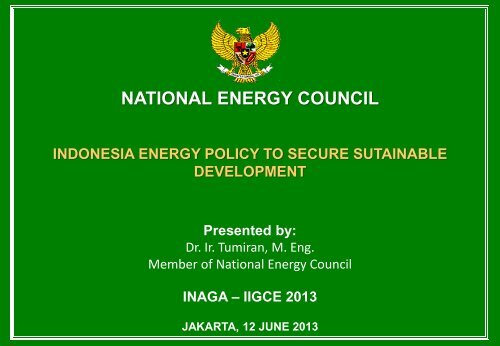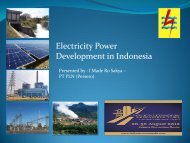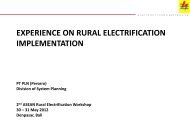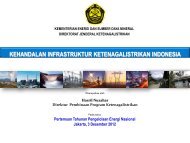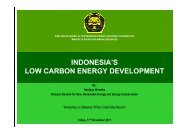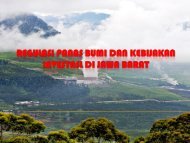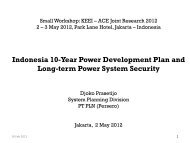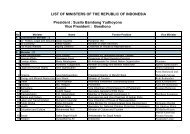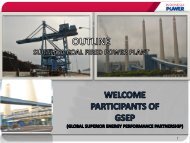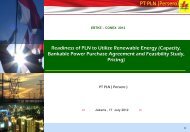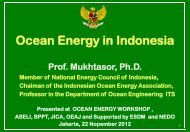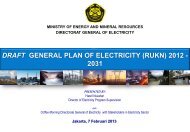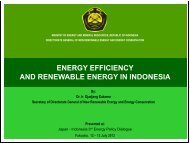energy mix
energy mix
energy mix
You also want an ePaper? Increase the reach of your titles
YUMPU automatically turns print PDFs into web optimized ePapers that Google loves.
NATIONAL ENERGY COUNCIL<br />
INDONESIA ENERGY POLICY TO SECURE SUTAINABLE<br />
DEVELOPMENT<br />
Presented by:<br />
Dr. Ir. Tumiran, M. Eng.<br />
Member of National Energy Council<br />
INAGA – IIGCE 2013<br />
JAKARTA, 12 JUNE 2013
DEWAN ENERGI NASIONAL<br />
NATIONAL ENERGY COUNCIL<br />
1
DEWAN ENERGI NASIONAL<br />
STRUCTURE of NEC<br />
CHAIRMAN<br />
Chairman : President<br />
Vice Chairman : Vice President<br />
Executive Chairman : Minister of Energy and Mineral Resources<br />
Government Representatives<br />
MEMBERS<br />
Stakeholders Representatives<br />
1. Minister of Finance<br />
2. Minister of National Development<br />
Planning<br />
3. Minister of Transportation<br />
4. Minister of Industry<br />
5. Minister of Agriculture<br />
6. Minister of Research and Technology<br />
7. Minister of Environment<br />
1. Ir. Agusman Effendi (Consumer)<br />
2. Prof. Ir. Rinaldy Dalimi, M.Sc, Ph. D<br />
(Academics)<br />
3. Dr. Ir. Herman Darnel Ibrahim, M.Sc<br />
(Industry)<br />
4. Dr. Ir. Tumiran, M.Eng (Academics)<br />
5. Prof.Dr. Ir. Mukhtasor, M. Eng. Ph.D<br />
(Environment Expert)<br />
6. Prof. Dr. Herman Agustiawan (Consumer)<br />
2
DEWAN ENERGI NASIONAL<br />
The ROLE OF NEC<br />
N<br />
E<br />
C<br />
Preparing and Formulating<br />
National Energy Policy (KEN)<br />
Determining<br />
National Energy General Plan<br />
(RUEN)<br />
Determining<br />
Guidelines in Addressing Energy<br />
Crisis and Emergency Situation<br />
NEC VISION<br />
To Ensure Energy<br />
Security that<br />
Support Sustainable<br />
National<br />
Development<br />
Monitoring and Supervising<br />
the Implementation of Cross –<br />
Sectoral Energy Policies<br />
3
DEWAN ENERGI NASIONAL<br />
RELATION OF NEP - NATIONAL ENERGY PLANNING<br />
University,<br />
Society,<br />
Local<br />
Government,<br />
Scientist,<br />
Industry sector,<br />
Other<br />
Stakeholders<br />
Law Num. 30/2007 on<br />
Energy<br />
NATIONAL ENERGY<br />
POLICY to 2050<br />
It Has been<br />
delivered to DPR<br />
by The president<br />
as NEC Chairman<br />
Law No. 30/2009 On<br />
Electricity<br />
RUED<br />
Province<br />
RUEN<br />
RUKN<br />
RUED<br />
Distric/city<br />
RUPTL<br />
4
DEWAN ENERGI NASIONAL<br />
ENERGY SOURCES<br />
Sources exploited<br />
from Mining :<br />
Resources are<br />
limited<br />
Sources come<br />
from many type:<br />
continuous,<br />
recycling and<br />
sustain<br />
Human being,<br />
environmental<br />
security,<br />
sustainability ,<br />
<strong>energy</strong> security,<br />
economic<br />
consideration<br />
5
DEWAN ENERGI NASIONAL<br />
Aplication of Energy<br />
1. Industrial Sector: Cement, textile, otomotive, garment, stell<br />
processing, food, manufactures, others.<br />
2. Office and management: Building, hotel, goverment and<br />
private office, education.<br />
3. Transportation: cars, bus, trucks, train, private car,<br />
4. Lighting: office, hotel, building, housing, road,<br />
5. Housing : cooking, cooling system, heating, lighting<br />
others.<br />
6. feedstock<br />
6
DEWAN ENERGI NASIONAL<br />
Growth of Energy Demand<br />
Factors affecting <strong>energy</strong> demand growth:<br />
1. Population Growth<br />
2. Economic growth<br />
3. Industrial Growth<br />
4. Administration , office and Hotel<br />
5. Human welfare<br />
6. Change of Daily activities habit<br />
7
DEWAN ENERGI NASIONAL<br />
World Energy Demand<br />
World economic growth is clearly linked to the increasing availability of<br />
<strong>energy</strong> sources. Three fuels, oil, coal and natural gas dominate the world’s<br />
primary <strong>energy</strong> market. According to IEA in 2011, world marketed <strong>energy</strong><br />
consumption grows by 53 percent from 2008 to 2035. Total world <strong>energy</strong><br />
use rises from 505 quadrillion British thermal units (Btu) in 2008 to 619<br />
quadrillion Btu in 2020 and 770 quadrillion Btu in 2035.Much of the<br />
growth in <strong>energy</strong> consumption occurs in countries outside the Organization<br />
for Economic Cooperation and Development (non-OECD nations) , where<br />
demand is driven by strong long-term economic growth. Energy use in<br />
non-OECD nations increases by 85 percent in the Reference case, as<br />
compared with an increase of 18 percent for the OECD economies<br />
8
DEWAN ENERGI NASIONAL<br />
WORLD ENERGY DEMAND GROWTH<br />
9
DEWAN ENERGI NASIONAL<br />
WORLD ENERGY DEMAND AND GROWTH<br />
10
DEWAN ENERGI NASIONAL<br />
NATIONAL ENERGY CONDITION<br />
11
DEWAN ENERGI NASIONAL<br />
Indonesia gas production,<br />
consumption and export<br />
12
INDONESIA COAL PRODUCTION AND<br />
EXPORT<br />
DEWAN ENERGI NASIONAL<br />
13
DEWAN ENERGI NASIONAL<br />
NATIONAL ENERGY SITUATION<br />
Low <strong>energy</strong><br />
access<br />
High<br />
Energy<br />
Demand<br />
Low<br />
<strong>energy</strong><br />
supply<br />
security<br />
Decrease<br />
fossil <strong>energy</strong><br />
reserve<br />
R&D Capacity of<br />
<strong>energy</strong> industry and<br />
infrastructure is not<br />
optimal<br />
NRE<br />
utilization is<br />
not optimal<br />
Current<br />
Condition<br />
Fossil <strong>energy</strong> as<br />
export<br />
commodity<br />
Inefficiency and<br />
low conservation<br />
on <strong>energy</strong><br />
management<br />
The New<br />
National<br />
Energy Policy<br />
To Ensure<br />
Energy<br />
Security that<br />
Support<br />
Sustainable<br />
National<br />
Development<br />
Energy<br />
reserve not<br />
available<br />
Energy price<br />
subsidized<br />
Geopolitic<br />
and global<br />
environment<br />
issue<br />
Energy Security is a condition ensuring the<br />
availability of <strong>energy</strong>, people's access to<br />
<strong>energy</strong> at affordable prices in the long term<br />
and is not affected by regional and<br />
international issue<br />
14
DEWAN ENERGI NASIONAL<br />
ECONOMIC AND ENERGY INDICATORS 2011<br />
No. INDICATOR INDONESIA JAPAN CHINA<br />
1 Population (thousand people) 241.134 127.360 1.344.130<br />
2 GDP (million US$) 846.832 5.867.154 7.318.499<br />
3 GDP/Capita (thousand US$) 3.512 46.067 5.445<br />
4<br />
5<br />
Final Energy Consumption<br />
(million TOE)<br />
Energy Consumption/Capita<br />
(TOE/Capita)<br />
119,2 334,7 2.613<br />
0,5 2,6 1,94<br />
6 Power Plant Capacity(GW) 34,5 287 1.073<br />
7<br />
8<br />
Electricity Consumption/Capita<br />
(kwh/Capita)<br />
Share Renewable Energy in<br />
Energy Mix<br />
655,2 8.746 3.488<br />
4,05% 16% 11%<br />
15
DEWAN ENERGI NASIONAL<br />
COMPARISON OF ELECTRICITY CONSUMPTION<br />
IN ASEAN COUNTRIES 2010<br />
No.<br />
Country<br />
Population<br />
(Million)<br />
Power Plant<br />
(Billion kWh)<br />
GDP/<br />
Capita<br />
Electricity per Capita<br />
(kWh/Capita)<br />
1 Brunei<br />
Darussalam<br />
0.39 3 54,400 8,308<br />
2 Singapore 4.66 41 48,500 8,185<br />
3 Malaysia 25.72 103 14,200 3,490<br />
4 Thailand 65.91 148 7,900 2,079<br />
5 Vietnam 86.97 61 2,500 799<br />
6 Indonesia 240.27 142 3,500 591<br />
7 Filipina 97.98 57 3,100 588<br />
8 Laos 6.83 2 1,900 178<br />
9 Cambodia 14.49 1 1,800 113<br />
10 Myanmar 48.14 6 1,100 97<br />
16
DEWAN ENERGI NASIONAL<br />
POWER PLANT GENERATION BY PLN 2011<br />
Sumber : Diolah dari berbagai sumber<br />
source: PT. PLN<br />
17
DEWAN ENERGI NASIONAL<br />
18
DEWAN ENERGI NASIONAL<br />
ENERGY SUBSIDIES<br />
2006 2007 2008 2009 2010 2011 2012<br />
Oil Price in APBN<br />
(US$/barel)<br />
63,8 69,7 97,0 61,6 80,0 110,0 90,0<br />
Fuel Subsidies (trillion Rp) 64,2 83,8 139,1 45,0 88,9 165,2 211,9<br />
Electricity Subsidies<br />
(trilion Rp)<br />
30,4 33,1 83,9 49,5 55,1 93,4<br />
94,6<br />
(103)<br />
Sumber : Diolah dari berbagai sumber<br />
Source: Kementerian ESDM<br />
19
DEWAN ENERGI NASIONAL<br />
ENERGY DEMAND FORCAST TO 2050<br />
20
DEWAN ENERGI NASIONAL<br />
KEY ASSUMPTION<br />
2010 2015 2020 2025 2030 2040 2050<br />
Population million 238 250 261 271 280 299 307<br />
Growth % 1,5 1,0 0,9 0,8 0,7 0,7 0,3<br />
World<br />
Population<br />
million 6.900 7.284 7.650 8.011 8.300 8.850 9.200<br />
GDP<br />
billion<br />
USD<br />
711 1.335 2.416 4.257 6.793<br />
12.98<br />
9<br />
20.16<br />
9<br />
Growth GDP % 6,6 13,4 12,6 12 9,8 6,7 4,5<br />
GDP/Cap USD 2.987 5.340 9.257<br />
15.70<br />
8<br />
24.26<br />
1<br />
43.44<br />
1<br />
65.69<br />
7<br />
21
DEWAN ENERGI NASIONAL<br />
ENERGY SUPPLY AND DEMAND TO 2050<br />
TARGET SATUAN 2015 2020 2025 2050<br />
Primary Energy Supply MTOE 215 290 400 1.000<br />
Primary Energy Supply per<br />
Capita<br />
TOE 0,9 1,1 1,4 3,2<br />
Power Plant Generation GW 49 79 115 430<br />
Electricity Consumption per<br />
Capita<br />
KWh 832 1308 2.500 7.000<br />
Target:<br />
• Energy Elasticity< 1 (year 2025)<br />
• Electrification Ratio : 100% (year 2020)<br />
22
DEWAN ENERGI NASIONAL<br />
NATIONAL ENERGY POLICY<br />
23
DEWAN ENERGI NASIONAL<br />
The Macro View of Energy Policy<br />
1. Changing paradigm in Energy Policy: Natural Resources from commodity to<br />
be National Development Assets.<br />
2. Improving efficiency, conservation, and special attention for sustainable<br />
development in the national <strong>energy</strong> management policy<br />
3. To increase the contribution of renewable <strong>energy</strong> in the national <strong>energy</strong> <strong>mix</strong><br />
continuously.<br />
4. To increase the fossil <strong>energy</strong> resources and proven reserved , and reduce it<br />
contribution (percentage) in the national <strong>energy</strong> <strong>mix</strong>.<br />
5. To improve independency in the National Energy Management, accelerating<br />
to open job creation, accelerating the role and participation of domestic<br />
industry in <strong>energy</strong> sector, and to boast research and development in <strong>energy</strong><br />
sector.<br />
6. To accelerate opening <strong>energy</strong> access for all people<br />
7. To secure <strong>energy</strong> supply, especially electricity, oil and gas.<br />
8. To optimize the using of Natural Energy Resources for Economic Development of the<br />
Nation based on “ Economic Added value Process”<br />
9. To improve the understanding that the fossil <strong>energy</strong> must be stored as long as<br />
possible to guaranty the security of the Nation to the all stake holders.<br />
10. To declare and securing The strategic National Energy reserved<br />
24
DEWAN ENERGI NASIONAL<br />
NATIONAL ENERGY POLICY DIRECTION<br />
1. Availability of Energy<br />
2. Priority of Energy Development<br />
3. National <strong>energy</strong> resources utilization<br />
4. National <strong>energy</strong> reserve<br />
5. Conservation and diversification<br />
6. Environment and Safety<br />
7. Price, subsidy, and incentive<br />
8. Energy infrastructure and industry<br />
9. Energy research and development<br />
10. Institution and Financing<br />
25
DEWAN ENERGI NASIONAL<br />
CONTRIBUTIONS OF ENERGY IN NATIONAL ECONOMY<br />
DEVELOPMENT<br />
Energy is one of the important input in economic development<br />
ENERGY<br />
OTHERS<br />
INPUT<br />
ECONOMIC<br />
OUTPUT<br />
26
DEWAN ENERGI NASIONAL<br />
ENERGY, INFRASTRUCTURE, TECHNOLOGY & NATIONAL<br />
DEVELOPMENT<br />
ENERGY<br />
SUPPLY<br />
• Renewable<br />
• Oil<br />
• Gas<br />
• Coal<br />
ENERGY<br />
TRANSFORMATION<br />
• Refining<br />
• Power Plant<br />
ENERGY<br />
DEMAND<br />
• Industry<br />
• Transportation<br />
• Commercial<br />
• Household<br />
INFRASTRUCTURE<br />
TECHNOLOGY<br />
Without any synergies between the above factors,<br />
the provision of <strong>energy</strong> demand growth will be<br />
interrupted so that sustainable development can not<br />
be achieved<br />
27
DEWAN ENERGI NASIONAL<br />
CONTRIBUTION OF ENERGY/ELECTRICITY IN INDUSTRIAL<br />
SECTOR<br />
Energi Fosil<br />
dan<br />
Non Fosil<br />
Kontribusi Energi Listrik (5-15)% Cukup, Handal, Berkualitas<br />
Sumber Alam 1<br />
Sumber Alam 2<br />
Sumber Alam 3<br />
SWASTA (85-95)%<br />
PRODUKSI<br />
PENGOLAHAN<br />
Tax<br />
Tax<br />
Produk<br />
Nilai Tambah<br />
Salary<br />
Multiplier<br />
PENCIPTAAN LAPANGAN KERJA<br />
Teknologi<br />
SDM<br />
Added Value<br />
Transformasi<br />
Brainware & Skill<br />
Teknologi<br />
Listrik Tidak Cukup,,,<br />
NOTHING<br />
28
DEWAN ENERGI NASIONAL<br />
ROLE OF RENEWABLE ENERGY TO SUPPORT ENERGY<br />
SECURITY<br />
29
DEWAN ENERGI NASIONAL<br />
5% Minyak Bumi Batubara<br />
2010 2025<br />
24%<br />
ENERGY MIX<br />
Gas Bumi<br />
EBT<br />
23%<br />
25%<br />
22% 49%<br />
30%<br />
22%<br />
(%)<br />
Realisasi tahun 2010, Pusdatin, KESDM<br />
2030<br />
25%<br />
22%<br />
31%<br />
20%<br />
2050<br />
30%<br />
23%<br />
25%<br />
24%<br />
30
DEWAN ENERGI NASIONAL<br />
GEOTHERMAL POTENTIAL<br />
PLTP SIBAYAK: 12 MW<br />
PLTP LAHENDONG: 80 MW<br />
PLTP WAYANG WINDU: 227 MW<br />
PLTP ULUBELU: 110 MW<br />
PLTP GUNUNG SALAK: 377 MW<br />
PLTP KAMOJANG: 200 MW<br />
PLTP ULUMBU: 5 MW<br />
PLTP DARAJAT: 270 MW<br />
PLTP DIENG: 60 MW<br />
Source: Badan Geologi KESDM (2011)<br />
Preliminary Survey Ready to be developed<br />
Detailed Survey<br />
Installed<br />
No. Island Total Location Potency (MW)<br />
1 Sumatera 86 13,470<br />
2 Jawa & Bali 76 10,013<br />
3 Nusa Tenggara 22 1,471<br />
4 Kalimantan 12 145<br />
5 Sulawesi 56 2,939<br />
6 Maluku & Papua 33 1,126<br />
TOTAL 285 29,164<br />
31<br />
31
DEWAN ENERGI NASIONAL<br />
GEOTHERMAL DEVELOPMENT ROAD MAP (2008 –<br />
2025)<br />
958 MW<br />
1442 MW<br />
1158 MW<br />
1400 MW<br />
3500 MW<br />
EXISTING<br />
MINING<br />
WORK<br />
AREA<br />
EXISTING<br />
MINING<br />
WORK<br />
AREA<br />
EXISTING<br />
MINING<br />
WORK<br />
AREA +<br />
NEW<br />
NEW<br />
MINING<br />
WORK<br />
AREA<br />
NEW<br />
MINING<br />
WORK<br />
AREA<br />
Presented by Minister ESDM in Bali<br />
2010<br />
32
GW<br />
DEWAN ENERGI NASIONAL<br />
POWER GENERATION CAPACITY FORCAST<br />
500<br />
450<br />
400<br />
350<br />
300<br />
250<br />
200<br />
150<br />
100<br />
50<br />
-<br />
2015 2020 2025 2030 2040 2050<br />
Geothermal Capacity 2 5 6 7 8 13<br />
National Capacity 49 79 115 159 270 430<br />
33
DEWAN ENERGI NASIONAL<br />
The Important in accelerating Geothermal<br />
1. To increase the security of Electric supply<br />
2. To Reduce the contribution of Oil for power plant<br />
3. To reduce Electricity Production Cost<br />
4. To bost Economic Growth in Geothermal Power Plant<br />
Region and area connected to electricity grid<br />
5. To create new Job<br />
6. To increase the contribution of Renewable Energy<br />
All the obstacle for implementing it must be over<br />
come<br />
34
DEWAN ENERGI NASIONAL<br />
THANK YOU<br />
DEWAN ENERGI NASIONAL<br />
4 th fl. Badiklat ESDM Building, Jl. Jenderal Gatot Subroto Kav 49<br />
Jakarta Selatan<br />
Tel. (+6221) 52921621<br />
Fax. (+6221) 52920190<br />
www.den.go.id<br />
35


